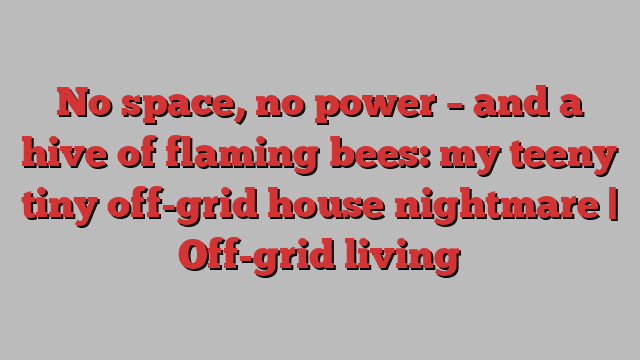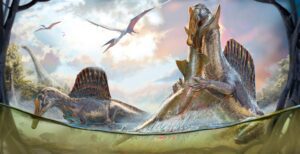
It is November. It is 3am and I am lying awake listening to the sound of rats chewing the electrical wires within the walls of my house. If you’ve ever heard mice or rats scuttling around in the walls, you’ll know how annoying it can be. Imagine that, but with the rats separated from your head by only a slice of MDF. The scratching and gnawing is so loud, I can’t get back to sleep.
Last night I spent the evening convincing my children that the noise is just a family of squirrels who have made a nest on our roof. We try to be kind to all creatures, here on our off-grid farm. There is something about rats, however, that triggers my panic response. Not least because Google research has told me that rats like to chew the insulation around electrical wires as a way to sharpen their teeth. So while the electrics might continue to function, this would come with an increased risk of sudden fire.
How had the rats got in? Well, first I should explain what my house actually is, and how we ended up living here. For the last three years I have been living off-grid. First in a caravan and now in a tiny house that is seven metres long, two and a half metres wide, and just tall enough to squeeze in two loft-style bedrooms under a roof decked with solar panels. A tiny house is in effect a well-built caravan. It’s a heavily insulated, A-rated building with triple-glazed windows. There is an air source heat pump, but no connection to the electricity grid. Despite weighing six tonnes, the house sits on a wheeled trailer, which means planning permission rules are more relaxed. Water comes from a 1,000-litre tank on a pile of pallets at the back of the house. Soon this will be fed from rainwater harvested from the roof, but for now it comes along a hosepipe from a tap in the next field. Wastewater goes into a wetland I dug with a spade and filled with gravel. Toilet waste is composted.
There is a growing movement of tiny-house owners in the US, where there are thought to be about 10,000 of them. But mine is in the corner of three acres of farmland in rural Essex, England. For the last 20 or 30 years, rabbits, deer and kestrels have ruled this field. When I moved here it was three acres of nettles, brambles and thistles. Being here is part of my attempt to live sustainably and experiment with all the different ways that an individual can help save the planet and humanity from the polycrisis of the climate emergency, pollution, deforestation and extractive capitalism.
Living off-grid is mad. You’d have to be a lunatic to choose to do it. And, it turns out, I am that lunatic.
Towards the end of the coronavirus pandemic, the world gave me an opportunity to look at all the elements of my life and change them. By which I mean I went through a separation, then divorce. So many people grumble along in vaguely unhappy situations simply because that’s what they have always done. But sometimes life forces us to reassess our choices. To step out of the groove we have made for ourselves.
For 10 years or so, I had been worrying about climate change and the environment. My awakening had come when I was living in a flat in south London, but spending most of my time travelling around the world performing my children’s comedy show. I flew back and forth across the Atlantic a dozen times, went to Australia four times and New Zealand twice. I was definitely using up more than my fair share of humanity’s carbon budget. My diet was terrible. I was living on microwave meals, takeaways and cocktails. I knew something was wrong.
One day I was given a copy of Hugh Fearnley-Whittingstall’s first River Cottage Cookbook. I devoured it and swiftly realised my future would involve living in the countryside, doing my best to be self-sufficient. First, I had to find a way to grow some food. The problem was I didn’t have any soil, just a tiny garden covered in concrete. One night, as I came home from a late-night comedy gig, I found a bathtub in the street. I dragged it home and somehow manoeuvred it into the garden. The next day I bought compost. It took a few trips but eventually there was enough to plant potatoes. I was amazed when along came the best I’d ever eaten.
From that point on, every time I moved, I acquired a bigger garden. I got out of London into Essex. The bath was replaced with veg beds and fruit trees. The thing was, though, that the houses got bigger and bigger, too. And the cars. And the carbon footprint. At my most bloated, I lived with my family in a five-bedroom house.
So back again to the divorce. I found myself in a position where I was able to really think about how I wanted to live. I had always felt happier in smaller spaces. I loved camping. I loved having to make conscious choices about what I actually needed. I spend a lot of time backpacking around Scotland. If you’re carrying it all, you don’t pack unnecessary items.
The decision I made was to buy a caravan and live off-grid. It wasn’t a fancy static caravan but a modest four-berth tourer. It was about 30 years old and cost me £2,000. I put a solar panel on top, wired an inverter into the electrics and installed a wood-burning stove. I lived in this on a friend’s campsite in Suffolk. My kids – now eight and 17 – would stay every other weekend and, yes, it was a squash and a squeeze. I will always remember my daughter in a tin bath in front of the fire. And tripping over my son’s legs to get to the other end of the van.
After a year I was given the chance to move my caravan to an unused field. It was covered in thistles and gnarly old nettles that bit like ferrets. There was an old orchard in one corner, so I cleared out a space and put the caravan under a plum tree. This became my new home as I slowly scythed out thistles and planted new trees and vegetable beds. After a year, my new partner and I decided to invest in a tiny house.
I could have bought a frame and filled in the rest myself, with the help of tradespeople. But we decided to go for the luxury end. We found a British company that would deliver the whole house on a lorry. All you had to do was switch it on, they said. It cost £65,000.
I would love to write that the house was great when it arrived in October 2022. Unfortunately, it turned out the people who built it didn’t seem to know anything about living off-grid, or electricity, or how to tell the truth. I tried to give them the benefit of the doubt. I wondered if maybe we had just been unlucky with our house. Then I decided that maybe they were incompetent – well-meaning but out of their depth. My conclusion now, though, is that their business is a malignant attempt to make money out of greenwashing innocent people.
There were so many problems. The house that was delivered was not the house in the brochure. We had ordered a pitched roof, so that solar panels would be pointed at the winter sun. The house that arrived had a pretty much flat roof.
At first, none of the electrics worked. They didn’t know why. The house sat empty for a month until they flew some people over from Latvia to fix it. That’s right, Latvia. On the company’s website they were very proud to state they are a British construction company. We thought the house would be made in England. Turns out it was made in Latvia, then trucked across Europe. Suddenly the carbon footprint wasn’t looking so dainty.
It was eventually worked out that the house simply wasn’t designed to be off-grid. The inverter and batteries had been fixed to the outside, where they got wet in the rain. Add to this the company’s failure to safely earth the house and we could easily have been killed. They also had no idea how many electrical appliances an off-grid system can power. They had installed an electric hob and oven; every time we switched the oven on, the entire house blew a fuse.
There followed a year of people flying to and from Latvia; of us being given impossible instructions as to how to fix the problems ourselves (at one point I did a QR code scan on the inverter, which said it was a socket set); and being told all the problems were my fault because I obviously didn’t understand how the house worked. We quickly got to the point where we asked them to take it away and give us our money back. They refused. We looked at suing them for mis-selling. Our solicitor reported they were in so much debt that if we did and won, they would go bankrupt and we would get nothing.
So we did our best to forgive them and try to find a way to make things work. They agreed to pay a UK-based company to replace the solar power system with something that actually worked, and switched the oven and hob for gas ones to take the load off the electrics.
One day, in the middle of all this, I heard a big crack, like a whip or a bolt of lightning. I walked around the house to discover a colony of bees. On fire. A hole had been left where the old inverter had been screwed into the wall. Some bees had moved in and made a nest around the exposed cable; when they connected the circuit with their bodies, a fault electrocuted them to death and set them alight. If a person had touched that 240V wire, it would have killed them.
Once the electrics were finally sorted, we were able to revel in such luxuries as switching on the hot water. It soon became apparent, though, that water was dripping from the underside of the house. There was a leak.
Three separate plumbers came, and one cut access hatches under the house to get at the plumbing. It transpired that the people who had built the house hadn’t actually connected the washing machine and shower to the outlet drain. All the greywater was flooding into the insulation in the floor of the house.
after newsletter promotion
This took them two months to address and, of course, required them to fly another team from Latvia to replace the bathroom. In the meantime, no one had thought to close up the access hatch made by the plumber. And that was how the rats got in.
Even at the best of times, the tiny-house life is not easy. Moving there from a regular house posed many transitionary challenges. First, I had to get rid of 90% of my stuff. If I hadn’t used something for a year, it went to a charity shop or the tip. When you live in a tiny house you also have to ask yourself, “Where would I keep it?” If an item has nowhere to go, there’s no point buying it.
The hardest thing to let go off was my books. I’ve always had a lot of books. A lot of us do. We tend to see them as a way of showing other people who we are. I decided to make the mental switch to realising that by keeping books I’d already read, I was depriving someone else of reading them. So 90% of those went to the charity shop. I now have one small shelf with maybe 50 books on it. Most are hard-to-replace reference books about permaculture and growing food sustainably.
Because there are no solid walls between the sleeping lofts and the rest of the house, I definitely know if someone is snoring. Practically speaking, we are all in the same room, but I think this brings us together emotionally. The concept of a child having their own room is quite a new one. Some people might say making a child separate from their parents at night isn’t healthy. I suppose it depends on your philosophies of parenting. I’m very keen on closeness and cuddling, and it helps me to hear my children breathing as they sleep.
Winter can be tough in a tiny house. All that outside space – gold dust for a child – becomes irrelevant. Everything has to be done inside. And that can get a bit claustrophobic. We go to the cinema, the library and the swimming pool much more in the winter. There’s nothing wrong, though, with accepting the tilt of the Earth and quietening down in the darker months. We don’t have a TV, but the children watch whatever is on iPlayer on my laptop and we snuggle in closely.
This isn’t a rich person’s hobby project, by the way. I’m not a trustafarian playing hippies. I was brought up in a single-parent family on a council estate, in a house where the walls were so thin, we could hear our neighbours talking in their kitchen. We had moved there to escape an awful situation. That council house was tiny, yet it was more than enough for us. There was no central heating but the open fire in the lounge also heated the water. I was very happy, even though life was hard sometimes. I have memories of the man from the Co-op coming round to collect his £1 for the life assurance and the three of us hiding behind the sofa because we didn’t have the money.
Those years gave me a sense that living within my means was a good idea, even though it took until middle age to work out its significance to me. We western humans seem to have convinced ourselves that things that were once luxuries are now necessities. We spend so much time spending money we don’t have to buy things we don’t need to impress people we don’t like.
This winter, though, there was simply not enough electricity to power everything. When the days are shorter and the sun lower, there’s not much energy for the panels. There is a petrol generator but unfortunately the house won’t connect with it and – surprise! – the manufacturers don’t know how to fix this problem.
Living with not quite enough electricity for three months a year means choices have to be made. The low-wattage stuff is fine. There is always plenty of power for the internet, lighting and charging devices. The big watt-gobblers are appliances that heat or move: the immersion heater, shower pump, toaster, fridge-freezer.
There have been plenty of days this winter when I’ve had just enough sunshine to get the water hot enough for a shower, but not enough to pump it to the shower. As a children’s author, I visit two or three primary schools a week and it’s important to turn up looking reasonably clean. Sometimes a cold shower is the only option.
I switched the fridge off back in November when I accepted there wasn’t going to be a working generator and I was going to have to tighten my electrical belt. Luckily, as the days got shorter and the battery level sank, it got colder outside and I could use a plastic box on the front step to keep my food cool. It helps that I choose a plant-based diet. Not a lot of my food needs refrigerating. In the middle of February, there was finally enough sunlight to switch the fridge back on. I can now eat hummus without sniffing it first – at least until next November, when I’ll switch the fridge off again.
Now, the rats have gone, the electricity works and there are no leaks. The next stage is to buy extra solar panels to go on the front of the house, so maybe next winter I’ll be able to have hot showers and a working fridge. I can smell spring in the air. The fruit trees are ready to blossom, the wrens are singing.
In January we had a tree-planting party and more than 40 people came. Thankfully, the weather was nice but in the invitation I explained that there would be no inside space. The night before, I forgot to check the plugs and left my son’s iPad charging overnight. This almost completely drained the battery and meant there was no hot water until after people started arriving. But my Uncle Stephen lit and maintained a fire pit outside, which gave everyone a focal point to sit round and keep warm. We told stories and laughed. I also managed to feed everyone soup from pumpkins grown in the field. And planted 200 trees, of course.
Do I regret getting into the whole tiny-house nightmare? Of course not. I wish we’d used a different company, or built our own from scratch, but I adore the off-grid life. The best thing is that I am now much more conscious of how I live and what resources I use. And awareness is transformational. The important thing for me is to take action – and to spread the word. Despite the hardships, the rats and the flaming bees, I’m the happiest I’ve ever been.

